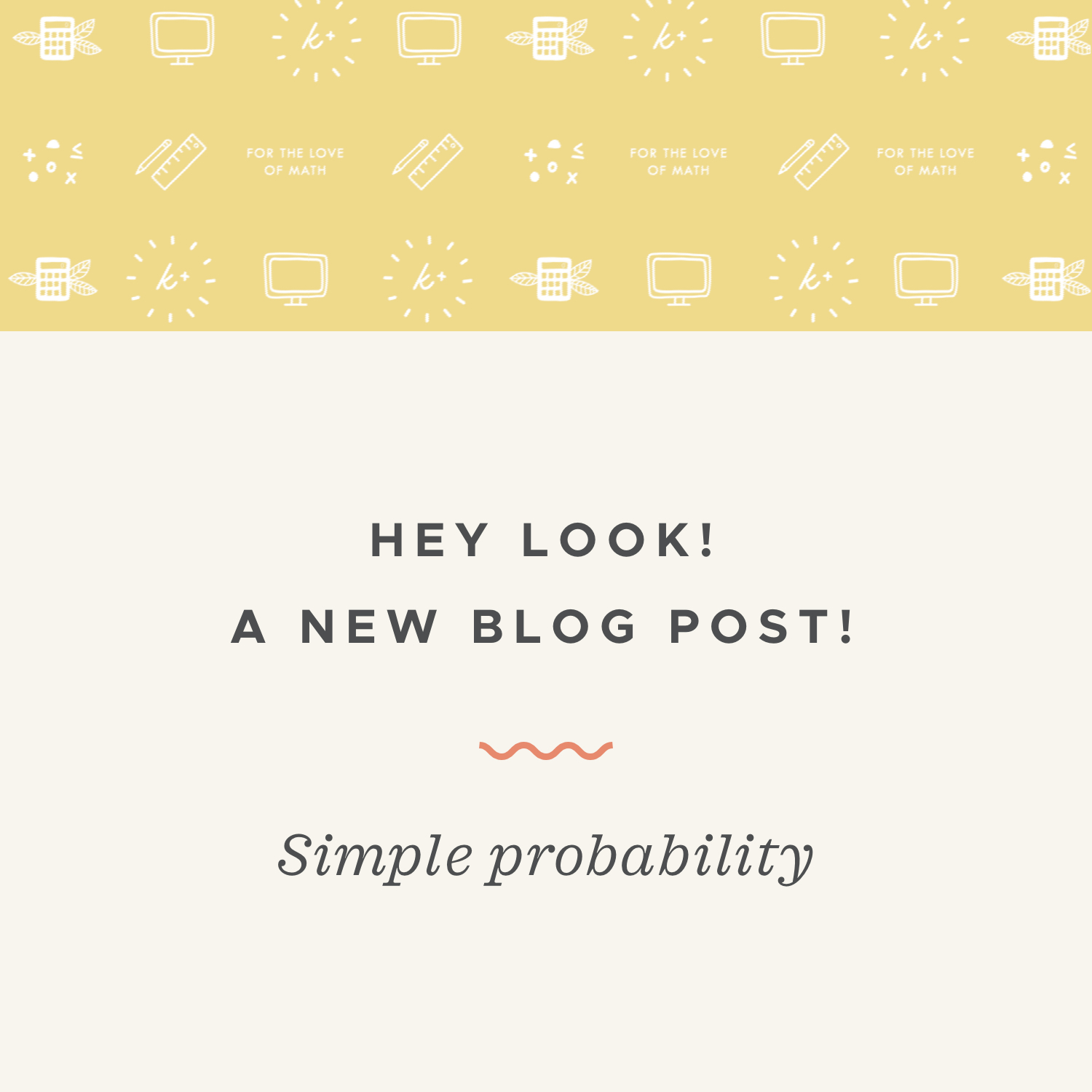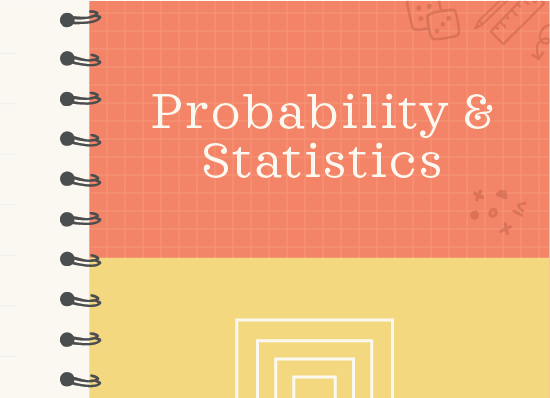Calculating basic probabilities
What is probability?
Up to now we’ve been talking about statistics, which is all about data, and how to display, summarize, and analyze data. Now we’ll transition into probability, which is all about the likelihood of whether or not some event will occur.
The reason we study statistics and probability together is because when we collect data as part of a statistical study, we want to be able to use what we know about probability to say how likely it is that our results are reliable. So in that way, statistics and probability go hand-in-hand.
Hi! I'm krista.
I create online courses to help you rock your math class. Read more.
Probability
So what is probability in its most basic form? Probability is how likely it is that something will occur. You can write a probability as a fraction, decimal or percent, but all probabilities are numbers equal to or between ???0??? and ???1???.
A probability of ???0??? means there’s a ???0\%??? chance that something will occur (it’s impossible), whereas a probability of ???1??? means there’s a ???100\%??? chance that something will occur (it’s guaranteed). Probabilities between ???0.5??? and ???1??? mean something is more likely to occur than not, whereas probabilities between ???0??? and ???0.5??? mean something is more likely not to occur. A probability of ???0.5??? means there’s an equal chance of the event occurring vs. not occurring.
Typically, we talk about something like the probability that we’ll get heads when we flip a coin, or the probability that we get a queen when we pull a card from a deck of playing cards.
But what we’re basically asking is, “How likely is it that we’ll get heads when we flip a coin?” or “How likely is it that we’ll get a queen when we pull a card from a deck?” How likely these things are depends on the full set of all possible outcomes, and how many of those possible outcomes meet our particular criteria.
We usually denote the probability of an event as ???P(\text{event})???. So the probability that we’ll get heads when we flip a coin is ???P(H)???, and the probability that we get a queen we we draw from a deck of cards might be ???P(Q)???. Let’s find these two probabilities.
The formula for simple probability is
???P(\text{event})=\frac{\text{outcomes that meet our criteria}}{\text{all possible outcomes}}???
The collection of “all possible outcomes” from the denominator is called the sample space.
Now think about flipping a coin. If we flip a coin one time, there are two possible outcomes: we’ll either get heads or tails. We want to know the probability of getting heads, and there’s only one outcome that satisfies this: heads. Therefore, the probability of getting heads is
???P(H)=\frac{1}{2}???
In other words, there’s a ???50\%??? chance that we’ll get heads when we flip a coin one time.
What about the probability of drawing a queen from a deck of playing cards. Well, there are ???52??? cards in a deck, which means there are ???52??? total possible outcomes. There are only ???4??? queens in the deck though, which means there are only ???4??? outcomes that meet our criteria. So the probability of drawing a queen is
???P(Q)=\frac{4}{52}=\frac{1}{13}???
Keep in mind that in order to use this simple probability formula, all of the possible outcomes need to be equally likely to occur. In other words, it needs to be equally likely that we’ll get heads or tails when we flip the coin. And it needs to be equally likely that we’ll pull any of the ???52??? cards in the deck. Which means that, when we’re dividing by “all possible outcomes” in the simple probability formula, we’re actually dividing by “all possible equally likely outcomes.”
???P(\text{event})=\frac{\text{outcomes that meet our criteria}}{\text{all possible equally likely outcomes}}???
Experimental and theoretical probability
Flipping a coin one time is one experiment. Drawing a card from a deck is one experiment. So when we talk about the probability of getting heads or tails when we flip a coin, we could do several experiments in a row.
For example, let’s say we flip a coin four times in a row. As you know, it’s completely possible that, just by chance, we end up with four heads in a row. Based on that result, we might say that the probability of getting heads is
???P(H)=\frac44=1=100\%???
But how can this be true? Before we saw that the probability of getting heads on one flip was ???50\%???, but now we’re calculating the probability of getting heads four times in a row at ???100\%???. What’s going on?
We’re looking at the difference between experimental and theoretical probability. Experimental probability (also called empirical probability) is the probability we find when we run experiments. Flipping four heads in a row tells us that we’ve found the experimental probability of getting heads as ???100\%???. But if we flip the coin a fifth time and get tails this time, then the experimental probability of getting heads after ???5??? experiments is
???P(H)=\frac45=0.8=80\%???
In other words, the experimental probability of an event will be constantly changing as we run more and more experiments over time. If the experiment is a good one, the idea is that over time the experimental probability will get very close to the theoretical probability.
Theoretical probability (also called classical probability) is the probability that an event will occur if you could run an infinite number of experiments. Or, you can think about the theoretical probability as the one we get from the simple probability formula:
???P(\text{event})=\frac{\text{outcomes that meet our criteria}}{\text{all possible outcomes}}???
We know from using this formula that the probability of getting heads when we flip a coin is ???50\%???. Therefore, the theoretical probability is ???50\%???, which means that the more experiments we run, the closer our experimental probability should get to ???50\%???.
This is also called the law of large numbers. It says that, if we could run an infinite number of experiments, that our experimental probability would eventually equal our theoretical probability.
How to calculate probability
Take the course
Want to learn more about Probability & Statistics? I have a step-by-step course for that. :)
Finding theoretical probability
Example
Find the theoretical probability of rolling an even number when you roll a -sided die one time.
Since we’ve been asked for theoretical probability, we’ll use the formula
???P(\text{event})=\frac{\text{outcomes that meet our criteria}}{\text{all possible outcomes}}???
How likely these things are depends on the full set of all possible outcomes, and how many of those possible outcomes meet our particular criteria.
We know that if we roll the ???6???-sided die, that there are ???6??? possible, equally likely outcomes: ???1,\ 2,\ 3,\ 4,\ 5,\ 6???. Of those possible outcomes, ???2???, ???4???, and ???6??? are even numbers, so there are ???3??? outcomes that meet our criteria. Therefore, the probability of rolling an even number is
???P(\text{even})=\frac36=\frac12=50\%???






